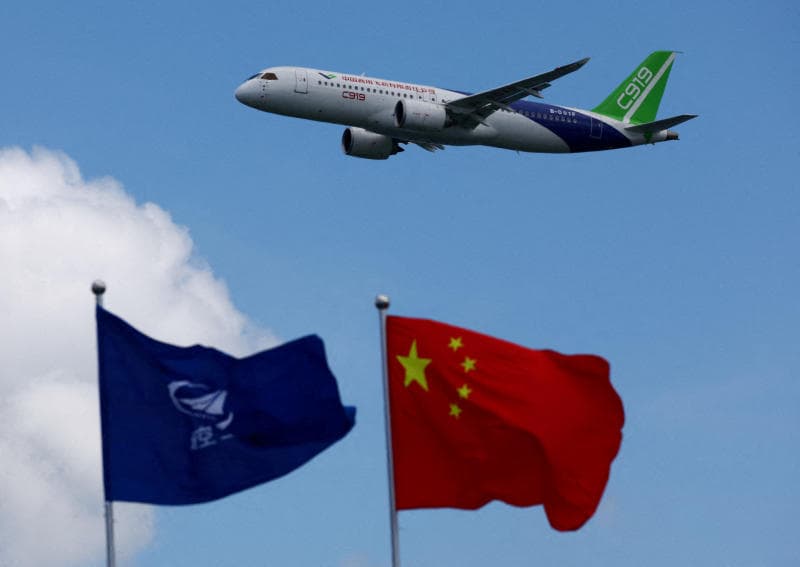Why this move matters now
Brunei has officially adopted China civil aviation certification standards, a policy change that clears the first regulatory hurdle for Chinese built jets, including the COMAC C919, to fly with Brunei registrations and service Brunei routes. Until now, Brunei recognized airworthiness certificates from Europe, the United States, and Canada. Adding China to that list signals a willingness to engage with Beijing aviation rulemaking and could encourage other Southeast Asian regulators to consider similar steps.
- Why this move matters now
- How certification and validation work
- What the C919 brings to the market
- Orders, interest, and the GallopAir bet
- What Brunei recognition does and does not do
- Regional ripple effects and competition
- Supply chains, engines, and geopolitics
- Safety, maintenance, and passenger perception
- What this means for Airbus and Boeing
- The Bottom Line
The decision arrives at a moment when airlines across Asia are planning fleet renewals and growth, yet delivery slots for popular Western models are scarce. COMAC, China state owned airframer, wants to turn the C919 into a credible third option next to the Airbus A320 family and the Boeing 737 family. Acceptance of China airworthiness codes by a Southeast Asian government gives COMAC a foothold in an important region for short and medium haul travel, where dense city pairs and rising passenger demand favor efficient narrow body aircraft.
Brunei is not a large market, but it is an influential one within ASEAN aviation diplomacy. The move follows a reported 2 billion dollar order from Brunei based startup GallopAir for 30 COMAC aircraft in 2023, including the C919 and a smaller regional jet known as the ARJ21 (referred to as C909 in some recent reports). GallopAir has described this as COMAC biggest international sale to date and likely the first overseas C919 purchase. AirAsia Group chief executive Tony Fernandes has said the low cost giant has discussed potential orders with COMAC. Interest from a regional heavyweight, combined with Brunei recognition of China standards, puts the C919 on more airline shortlists.
How certification and validation work
Civil aviation regulators use a layered process to approve aircraft. Step one is the development of airworthiness codes, the technical rulebook that sets out design and safety requirements. The Civil Aviation Administration of China, or CAAC, publishes its own codes, just as the European Union Aviation Safety Agency and the US Federal Aviation Administration do. Step two is type certification. The home regulator evaluates whether the aircraft meets its code and issues a type certificate. The C919 already holds a CAAC type certificate for operation in China. Step three is validation by foreign regulators that want to allow local airlines to operate the aircraft, or to recognize maintenance and pilot training standards for that type.
Recognition versus validation
Brunei decision is about recognizing the CAAC airworthiness code, not a blanket approval for every aircraft designed under it. That recognition makes later steps more straightforward, because Brunei authorities can evaluate a CAAC certified aircraft against a code they already accept. The C919 would still need Brunei specific validation and inclusion on the relevant operator certificates before commercial service can begin with a Brunei airline.
Airlines also need route permissions. Scheduled and charter flights depend on bilateral air services agreements between countries. Those agreements often reference whether a country trusts the other side aviation oversight and the airworthiness of aircraft involved. With the code recognition completed, Brunei can move more quickly on the technical side when an airline applies to fly the C919, while destination countries decide whether to accept the aircraft for their markets.
Why European or US approvals differ
Validation from EASA or the FAA is a separate path. Many regulators around the world have long standing working arrangements with Europe or the United States, including mutual recognition in some areas. Without EASA or FAA validation, the C919 cannot fly for airlines in those markets, and operations into those regions would require special arrangements. For Southeast Asia, the key is whether each national regulator is comfortable with CAAC standards and whether local airlines can support the aircraft with training, maintenance, spares, and software updates.
What the C919 brings to the market
The C919 is a narrow body passenger jet aimed squarely at the workhorse segment dominated by the A320 family and the 737 family. It is designed for short and medium haul routes that connect regional hubs and secondary cities, a sweet spot for Southeast Asian carriers. The aircraft uses CFM International LEAP 1C engines, advanced flight controls, and a modern glass cockpit. Seating and range vary by configuration, allowing airlines to tailor layouts for business heavy trunk routes or dense leisure traffic.
C919 at a glance
- Typical seating roughly 158 to 192 passengers depending on layout
- Advertised range in the mid four thousand to mid five thousand kilometer band depending on variant
- LEAP 1C engines supplied by CFM International, a joint venture of GE Aerospace and Safran
- Flight deck with large format displays and fly by wire controls designed to ease pilot transition from comparable types
- Aim to deliver operating economics in line with current generation A320 and 737 models
For airlines, the practical question is dispatch reliability, maintenance demands, pilot training pipelines, and lifecycle cost. The C919 is relatively new in service, so performance data outside China is limited. Early adopters may receive pricing and support packages to offset the risks that come with introducing a new type. If COMAC can keep utilization high and parts available, the aircraft can compete in markets where purchase price and delivery timing carry significant weight.
Orders, interest, and the GallopAir bet
GallopAir, a Brunei based startup, announced plans in 2023 to take 30 COMAC aircraft, including the C919 and several ARJ21 regional jets. The airline has described the deal as COMAC largest international sale and indicated a seven year plan to connect four countries in Southeast Asia with cities in China. That network would focus on point to point routes that can be served efficiently by a mix of regional jets for thinner city pairs and the C919 for higher demand sectors.
Brunei has only international routes, given its small population of about 462,000 people and lack of domestic air travel. Royal Brunei Airlines already connects the sultanate to regional capitals and long haul destinations using Airbus and Boeing types. A second operator flying Chinese built aircraft would give the country more flexibility in fleet sourcing and could expand route options if financing and recruitment align with regulatory approvals.
Interest is not limited to Brunei. AirAsia has publicly said it is in discussions with COMAC about potential orders. Low cost carriers operate intense daily cycles on short segments, which stresses reliability, turn times, and maintenance planning. If the C919 can deliver consistent daily utilization with competitive fuel burn and support, it could be attractive to value driven operators that also like to diversify suppliers.
What Brunei recognition does and does not do
Recognizing CAAC airworthiness codes gives Brunei regulators a rulebook they are prepared to use when assessing Chinese designed aircraft. It does not automatically place the C919 on a Brunei operator certificate. COMAC still needs to present documentation, test data, and compliance evidence for local validation. Airlines will need pilot type ratings, simulator access, and maintenance instructions tailored to local requirements.
International flying adds another layer. Each destination country must be satisfied that the aircraft type is safe and that oversight meets International Civil Aviation Organization standards. In Southeast Asia, many authorities have experience working with CAAC certified aircraft, as seen with the ARJ21 introduction to the region. Outside the region, some regulators may be slower to devote resources to validation until there is a firm commercial case.
The support ecosystem matters as much as paperwork. Airlines will expect COMAC and its partners to stand up spare parts depots, line maintenance capability at key airports, and training for engineers and technicians. Supply chains and maintenance practices in the region are deeply built around Airbus and Boeing fleets. Integrating a new type means new tools, new software, and new vendor relationships, all of which take time to mature.
Regional ripple effects and competition
Southeast Asia is a growth engine for global aviation, with Indonesia, Vietnam, the Philippines, Malaysia, Singapore, and Thailand rebuilding capacity and opening new city pairs. A third large manufacturer adds bargaining power for airlines and gives governments more options in their aviation partnerships. The region already has some experience with Chinese aircraft through the ARJ21, which began flying outside China with an Indonesian operator. Those operations create a baseline for regulators and airlines, covering training, maintenance approvals, and day to day performance in tropical, high utilization environments.
For airlines planning fleet decisions in the late 2020s, delivery timing is a major constraint. Airbus and Boeing have deep order backlogs for the A320neo and 737 MAX families. New slots can be many years out. If COMAC can offer earlier delivery positions, especially for carriers that need capacity to capture post pandemic growth, it may win orders even before it achieves wider Western validations. Price will play a role, but long term support and residual values will dominate financial models for lessors and airlines alike.
Supply chains, engines, and geopolitics
The C919 relies on an international supplier base. Its LEAP 1C engines come from CFM International, and many avionics, flight control systems, brakes, and cabin components are sourced from European and US companies. This approach helped COMAC move faster toward certification, tapping proven technologies. It also creates exposure to export controls, licensing reviews, and broader trade tensions, any of which can affect schedules for deliveries or parts.
Policy debates over tariffs and technology restrictions have already affected parts of the aerospace value chain. Even when headline risks fade, airlines focus on practical questions, such as how quickly an engine can be swapped, whether a software update can be deployed remotely, and how many days a component spends in repair. COMAC is working on a domestic engine program, often referred to as the CJ 1000A, to reduce dependence on foreign suppliers over time. That development continues in parallel, while early production C919s use the LEAP 1C. For prospective buyers, the key is that the support network for the installed engine remains robust across the aircraft lifecycle.
Safety, maintenance, and passenger perception
Safety standards are set by regulators and implemented by airlines and manufacturers through certification, training, and maintenance. The C919 entered commercial service in China in 2023 with China Eastern Airlines, giving COMAC real world operational data. Dispatch reliability and turnaround performance in Chinese service will inform Southeast Asian operators as they evaluate the type. Airlines will pay close attention to simulator availability, pilot conversion times, and the volume of service bulletins in the early years.
Passenger experience will be influenced by seat layout, cabin noise, and onboard amenities, which are airline choices more than manufacturer choices. If airlines can maintain reliable schedules and provide a familiar cabin experience, passengers tend to view the C919 similarly to other modern jets. Over time, confidence grows as more flights operate without incident and as crews and maintenance teams gain experience.
What this means for Airbus and Boeing
Airbus and Boeing will continue to dominate global narrow body deliveries for years, given their massive installed fleets and backlogs. Brunei recognition of Chinese airworthiness codes will not change that overnight. It does, however, create more competition in a region where both Western manufacturers have sold hundreds of aircraft. A credible third option can pressure pricing, support terms, and delivery schedules. That dynamic benefits airlines that negotiate with all three suppliers.
For now, Chinese built aircraft are most likely to enter service with state linked carriers, startups, and airlines that see value in close ties with China or that prize near term delivery slots. If early operators report strong reliability and favorable economics, acceptance will spread. The ability of COMAC to scale training, parts, and repairs across multiple countries will determine how fast that happens.
The Bottom Line
- Brunei has accepted China civil aviation airworthiness code, creating a clearer path for the COMAC C919 in Southeast Asia.
- The decision follows a reported 2 billion dollar GallopAir order for 30 COMAC aircraft that includes the C919.
- Recognition of the code is a first step; Brunei still must validate the C919 for local operations and airlines need approvals and training.
- Air service agreements and destination country evaluations remain necessary for international routes.
- AirAsia has discussed potential orders with COMAC, signaling interest from a major regional carrier.
- The C919 targets the same segment as the A320 and 737 families, with seating around 160 to 190 and range suited to regional networks.
- Western suppliers power key systems on the C919, including LEAP 1C engines, which brings both maturity and geopolitical exposure.
- A tight delivery landscape for Airbus and Boeing could help COMAC win early customers that want earlier slots.




